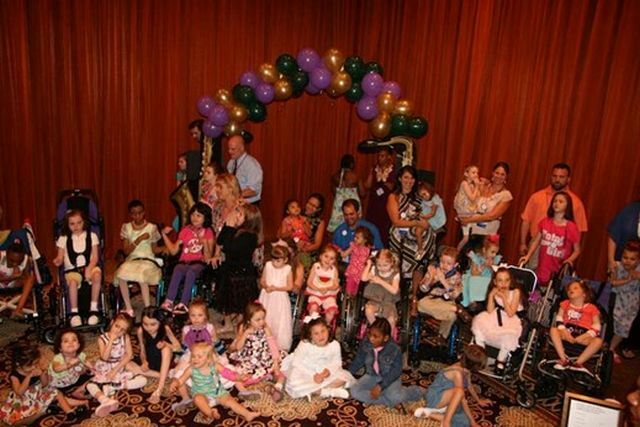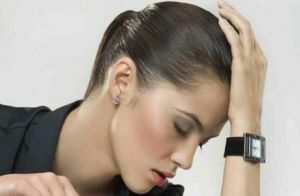 Vestibular neuronitis is a disease of the inner ear that occurs against a background of acute inflammation of the nerve, which leads to the semicircular canals of the vestibular apparatus.
Vestibular neuronitis is a disease of the inner ear that occurs against a background of acute inflammation of the nerve, which leads to the semicircular canals of the vestibular apparatus.
Pathology is characterized by severe attacks of dizziness, nausea, vomiting, imbalance and coordination. In this case, dizziness can be amplified by changing the position of the body and turning the head.
The first attack of dizziness can last from a few hours to a week or more, and then go by suddenly. Sometimes it arises separately in the form of an isolated attack or in the form of a series of seizures, which are repeated for 1-1,5 years.
Each subsequent attack is less durable and painful than the previous one. In this case, the hearing organs are not affected. Shakiness and instability can persist for several weeks. Sometimes a harbinger of an attack can be a violation of balance and coordination of movements.
Modern medicine divides the vestibular neuronitis into two forms:
- acute - completely disappears for half a year;
- chronic - is accompanied by constant instability and rare attacks of dizziness.
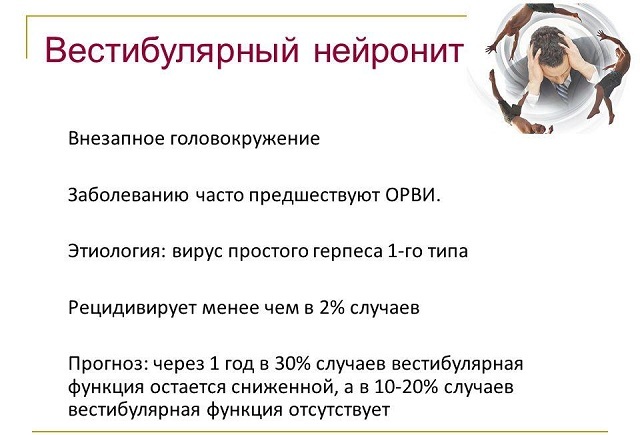
Where can I find the root of the problem?
The causes of vestibular neuronitis can be:
- viruses ( in particular herpes simplex virus);
- poisoning ;
- infectious diseases - influenza, angina, sinusitis, inflammation of the upper respiratory tract;
- allergic processes in the body ;
- metabolic disorder .
Experts believe that it is the virus that is the primary cause of the development of this pathology. Often signs of the disease manifest after about two weeks after the onset of an acute respiratory illness. In addition, there is a certain pattern of an upsurge in cases of morbidity, which occurs at the end of the spring period.
According to statistics, there were cases when VN fell ill members of the same family at about the same time. It is also known that vestibular neuronitis can occur as a consequence of herpetic encephalitis.
Symptomatic picture of the disease
Vestibular neuronitis often occurs suddenly, the most basic symptom of this disease is dizziness, because of which the person  completely loses balance.
completely loses balance.
In this case, the patient has a feeling of rotation of his own body and objects in space, as well as the feeling that he is thrown up. Discomfort brings everything - any slightest movement, a turn of the head or a glance from one subject to another. When fixing the eyes at one point, dizziness decreases.
In addition to the main symptom of illness,
- is observed. Nausea with vomiting of , which does not bring any relief.
- Equilibrium violation .First, a person can not walk on his own, then for a while his gait remains unstable. The coordination of not only the legs, but also the arms has been disturbed. The movements of such a patient are blurred, it is difficult for him to hold a spoon in his hands, write, button up buttons.
- Nystagmus - involuntary eye movements. The movements are directed toward the unaffected part of the body, for example, with the left-sided WN the eyes will be turned to the right. The duration of this condition can be different - from two to three days to several weeks.
Diagnosis of
In the diagnosis of this disease, the correct collection of anamnesis plays a huge role. It is important for a specialist to establish a causal relationship to determine the true cause of the disease. To do this, you need to talk with the patient about the presence of factors that could contribute to the development of pathology, to find out when and how the first attack began, whether he had previously had any kind of an infectious-viral illness.
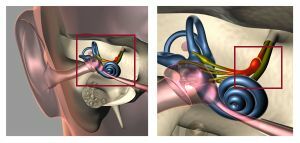 Diagnosis can be complicated, as the clinical picture is largely similar to the symptoms of other diseases. An important criterion that allows you to establish an accurate diagnosis is the absence of hearing impairment.
Diagnosis can be complicated, as the clinical picture is largely similar to the symptoms of other diseases. An important criterion that allows you to establish an accurate diagnosis is the absence of hearing impairment.
In other diseases of the nervous system and the vestibular apparatus, along with other symptoms, hearing impairments are detected, with the vestibular neuronite being affected solely by the vestibular nerve.
Also, the disease is not accompanied by focal symptoms, since the rest of the nervous system structures are not affected.
Diagnostics includes such methods:
- Audit of hearing .
- Caloric test - the patient is given a weak rotation. With inflammation of the vestibular nerve, a decrease or absence of reflexes on the affected side will be detected.
- The caused myogenic potentials - check the function of the otolith organs of the inner ear with a loud click.
- MRI and CT of the brain - are performed to differentiate VN from cerebral circulation disorders.
- Resistance test in Romberg position .For this, a person puts his feet on one line in such a way that the heel of his right foot touches the toe of the left, while he needs to extend his hands to the sides. If a person is sick with vestibular neuronitis, he will not be able to perform this exercise.
- Electronystomography is a method of recording eye movements for the study of nystagmus. To do this, a few drops of cool water are buried in the auditory canal and simultaneously register eye movements.
Therapeutic package
The main direction of therapy for vestibular neuronitis is symptomatic treatment, i.e., relief of leading symptoms: nausea, vomiting, dizziness, impaired coordination. For this purpose, such drugs are prescribed:
- vestibular suppressants - blockers of H1-histamine receptors: Dramina, Dedalon, Ciel;

- histamine : Betagistin, Betaserk, Vestibo, Westinorm, they facilitate central vestibular compensation;
- antiemetic drugs : Metoclopramide, Cerucal, Osetron, Scopolamine;
- sedative sedative effect : Gidazepam, Sibazon, Rudotel;
- diuretics : Furosemide, Lasix, Diacarb, Spironolactone - relieve edema of nerve fibers.
Often the use of these medicines gives a positive result, and the symptoms are largely reduced after a few days. After nausea and vomiting pass, and dizziness stops worrying the patient, he is recommended to perform special gymnastics.
Gymnastic Exercises
Gymnastics involves performing a series of exercises with a fixation of the glance at one point under different angles, the rotation of the eyes, as well as the turns of the head and trunk.
The goal of gymnastics is the flow of signals from different senses into the brain, which leads to a sensory imbalance, in other words, a false dizziness is recreated. Together with this, such movements make it possible to increase the threshold of excitability of the vestibular apparatus. Vestibular loads and the nature of the exercises are determined depending on the stage of the disease.
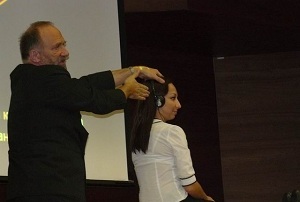 At first, performing these exercises can cause an imaginary deterioration of the state, but in no case should the activity be interrupted. It is necessary to overcome the feeling of discomfort, in time it will pass.
At first, performing these exercises can cause an imaginary deterioration of the state, but in no case should the activity be interrupted. It is necessary to overcome the feeling of discomfort, in time it will pass.
The duration of such procedures will depend on the individual characteristics of the vestibular apparatus. Determine exactly when it is impossible to improve. The minimum period for conducting classes is one month. With their regular implementation, it is possible to achieve recovery and return work activities.
Surgical intervention in this case is not provided.
Consequences and prevention
The forecast in most cases will be favorable. The disease does not cause any serious complications. After the disappearance of all symptoms, the disease is cured. 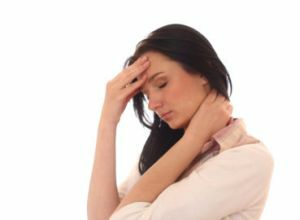
Because of the transferred vestibular neuronitis in 40% of patients during the year, the vestibular function is restored completely, in 30% of people it is only partially restored, in other cases, vestibular dysfunction remains for life.
With incomplete recovery of vestibular function, a person will not feel serious discomfort or experience problems with coordination and balance. Sometimes the disease can recur, but the healthy side will already be affected.
Because there is a connection between the occurrence of VN and viral diseases, the only preventive measure is their prevention and timely treatment. It is also very important, when unpleasant symptoms appear, to take timely measures and start treatment as early as possible.

